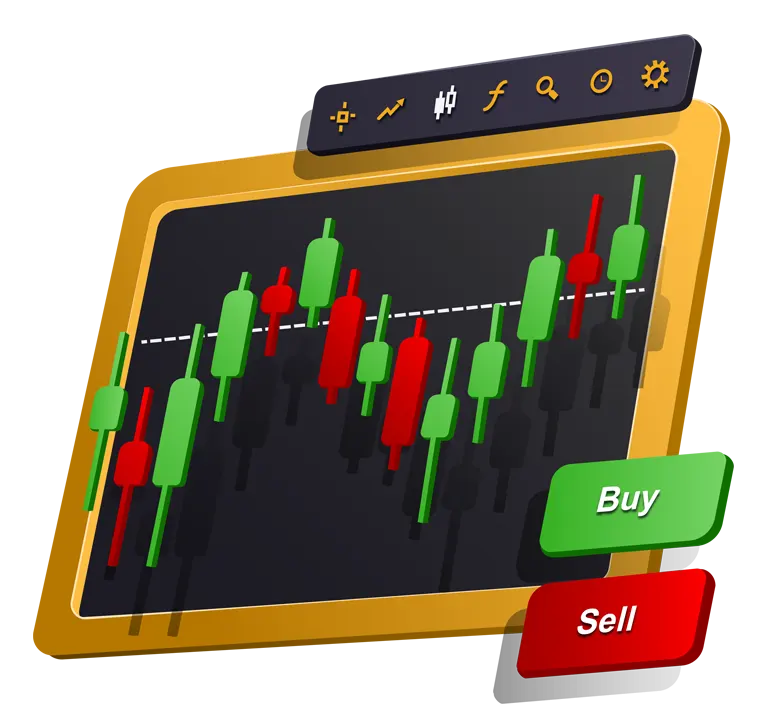Тази статия е подробен наръчник, за това как да стартираш Форекс търговия. Така че, ако искаш да изградиш солидна основа, съветите и стъпките в това ръководство ще ти бъдат много полезни.
Нека започваме.
Съдържание
Какво е Форекс търговия
Участници на пазара
Какво да търгуваш
Кога да търгуваш
Важни форекс термини
Какво е маржин
Избор на брокер
Демо сметка
Платформа за Форекс търговия
Технически анализ
Фундаментален анализ
Форекс стратегия
Управление на капитала
Обобщение
Какво е Форекс търговия
В тази част ще отговоря на въпроса, какво точно представлява Форекс търговията.
Тъй като това е основата, всеки трейдър трябва да знае с какво всъщност се занимава.
И така …
Най-просто казано, това е глобален пазар, който позволява търговията на една валута срещу друга.
Ако смяташ, че еврото ще бъде по-силно от долара, може да купиш валутната двойка EUR/USD и да спечелиш от разликата в курса.
Как точно да го направиш, ще разбереш надолу в статията.
Ако пътуваш до друга държава, ще ти трябва валутата използвана в тази държава. Трябва да отидеш до обменното бюро и да обмениш валутата, която имаш за валутата на страната, която посещаваш.
Ще забележиш, че има различни цени, тези цени се наричат обменни курсове.
Да предположим, че ще ходиш на екскурзия в Австралия и трябва да обмениш 1000 лева. Това, което всъщност ще направиш, е да си купиш австралийски долари на стойност 1000 лева.
Или с други думи, ще участваш на Форекс пазара, чрез сделка за покупка на австралийски долари и продажба на левове.
Текущият обменен курс, е 1.286 лева за 1 австралийски долар, което означава, че ще получиш приблизително 777.6 австралийски долара в замяна на твоите 1000 лева.
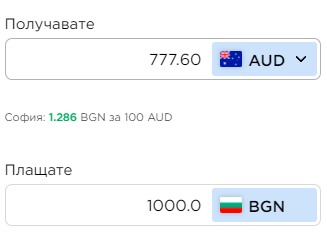
Да предположим, че по някаква причина не си похарчил доларите и искаш да ги продадеш, за да си купиш левовете обратно.
Този път обаче, обменният курс се е променил и вече е 1.386 лева за 1 австралийски долар. Това означава, че ще получиш 1 077.75 лева в замяна на твоите 777.6 австралийски долара.
Тази промяна във валутните курсове ти позволява да реализираш печалба от Форекс търговия.
FOREX идва от FOReign EXchange market и е най-големия финансов пазар в света.
Форекс е глобален, децентрализиран пазар, което означава, че няма конкретно място на което се сключват сделките. Както например фондовата борса.
Форекс пазара е създаден, за да обслужва международната търговия и инвестициите, но в момента той се използва предимно със спекулативна цел.
Спекулантите (трейдърите) купуват валути с надеждата да ги продадат след време на по-висока цена и да спечелят от разликата, както в примера по-горе.
Месечният търгуван обем на най-голямата фондова борса в света New York Stock Exchange (NYSE) е около 1,45 трилиона долара.
В таблицата по-долу са отразени месечните обеми на четирите най-големи фондови борси в света.
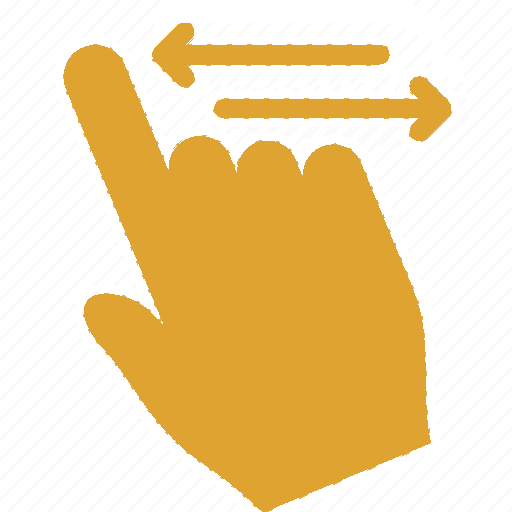
Rank | Year | Stock Exchange | Region | Monthly Trade Volume (USD billion) |
|---|---|---|---|---|
1 | 2019 | New York Stock Exchange | United States | 1,452 |
2 | 2019 | Nasdaq | United States | 1,262 |
3 | 2019 | Japan Exchange Group | Japan | 481 |
4 | 2019 | London Stock Exchange | United Kingdom | 219 |
*Източник Wikipedia
За сравнение, само дневният обем на Форекс пазара е над четири пъти по-голям от месечния обем на NYSE - 6,595 трилиона долара.
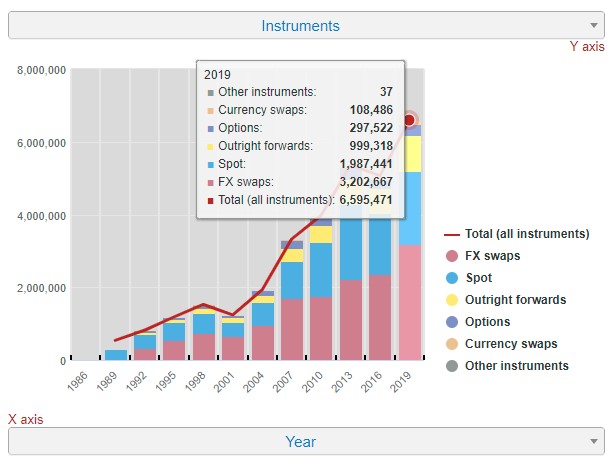
*Източник Bis.org
Както виждаш валутния пазар е огромен, но оборота от 6,595 трилиона долара отразява всички сделки. Докато “Spot” пазара, от който са част малките инвеститори и трейдъри, е почти 2 трилиона долара.
За да стане по-ясно, когато си отвориш реална сметка в инвестиционен посредник и сключиш сделка с валутна двойка, ти участваш на “Spot” пазара, който е част от Форекс пазара.
Освен огромния си размер, форекс пазара работи 24 часа в денонощието, 5 дни в седмицата. За разлика от фондовите борси, които затварят в края на всеки работен ден.
Сега може би се чудиш:
Кой търгува на Форекс пазара и генерира такъв обем?!
Точно това ще разгледаме в следващата част.
Продължаваме напред …
Участници на Форекс пазара
Важно е да разбереш, кой участва в търговията и с каква цел, за да знаеш кога да търгуваш и кога да стоиш далеч от пазара.
Сега ще те запозная с основните участници, които генерират обема на Форекс пазара.
- Търговски банки;
- Правителства и централни банки;
- Търговски дружества;
- Инвестиционни фондове;
- Трейдъри за собствена сметка.
Търговски банки
Обективно погледнато Форекс е междубанков пазар, чиято структура се формира предимно от големите търговски банки. Останалите участници на пазара осъществяват транзакциите си през тях.
Тъй като са основни пазарни участници, банките разполагат с много информация и достатъчно капацитет за анализ на тази информация и в крайна сметка да я използват в своя полза.
Ако някой голям клиент на банката възнамерява да се позиционира в определена посока, банката ще знае това и може да се възползва, като изгради стратегията си в същата посока.
Също така търговските банки притежават сериозни капитали, което им позволява да участват на валутния пазар чисто спекулативно за собствена сметка.
Ето някои от най-големите търговски банки, предлагащи валутна търговия:
- JPMorgan;
- Deutsche Bank;
- UBS;
- Citi;
- HSBC.
А в таблицата по-долу може да видиш водещите компании предлагащи търговия с валута в световен мащаб към юни 2020 г. по пазарен дял.
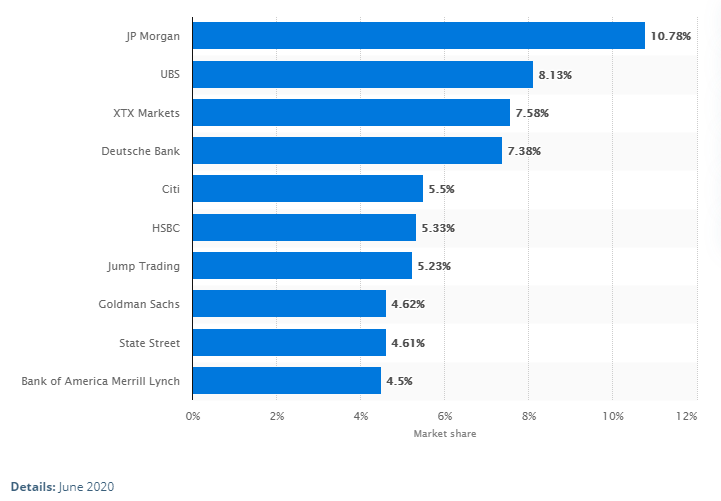
*Източник интернет
Правителства и централни банки
Подобно на другите участници, правителствата се включват на валутния пазар, за да осъществят международни търговски плащания и/или да управляват активно валутните си резерви.
Централните банки също са редовен участник на валутния пазар.
Те контролират търсенето и предлагането на дадена валута, като се намесват на пазара, чрез покупки или продажби на съответната валута. Тези намеси на пазара се наричат интервенции и имат за цел да съдейства за монетарната политика на страната.
Правителствата и централните банки могат да повлияят на курса на валутата чрез пряка или косвена намеса. Пряката намеса означава директна покупка/продажба на валута чрез пазарна интервенция.
Но може също така да повлияят на цената, чрез изказване направено по време на редовните си пресконференции.
По-добре да стоиш извън пазара по време на тези събития.
Разбери повече за участниците на пазара, както и за начина на търговия по време на новини, като се регистрираш за безплатното обучение на Trendline.
БЕЗПЛАТНО ФОРЕКС ОБУЧЕНИЕ ЗА НАЧИНАЕЩИ
Ако искаш да търгуваш GOLD, FOREX или други инструменти и да правиш реални печалби, нашият трейдинг курс е точно за теб. Пълно ръководство за начинаещи в рамките на 38 видео урока.
Търговски дружества
Търговските дружества са участниците, които използват валутния пазар, за да обслужват интересите на бизнеса си.
Те не се интересуват от спекулативна търговия, а реално имат нужда от покупко-продажба на валута. Такава необходимост произтича от международната търговия на стоки и услуги.
Например австралийско дружество търгува със САЩ и получава заплащане в щатски долари. Същото дружество обаче, трябва да изплати заплати на служителите си в местна валута - австралийски долари.
Това е пример за продажба на щатски долари и покупка на австралийски долари, по необходимост произтичаща от естеството на бизнеса.
Инвестиционни фондове
Това са участниците на пазара, които целят само и единствено печалба от спекулативна търговия.
Такива фондове разполагат с огромен ресурс, тъй като хората насочиха инвестициите си към тях, вместо да ги държат в банките на почти нулеви лихви. Тъй като целта им е печалба и нищо друго, те са способни на всичко, за да я постигнат.
Освен това те имат таргети, които трябва да изпълнят и служителите им (трейдърите на фондовете) получават тлъсти бонуси, ако постигнат целите си и дори ги надминат.
Техните действия са продиктувани от стремежа към печалба и не са съобразени с фундаментални и икономически зависимости.
Важен период за фондовете е края на годината, тъй като тогава се разглежда изпълнението на таргетите и се определят бонусите.
Трейдъри за собствена сметка
Индивидуалните трейдъри са най-голямата група участници на Форекс пазара.
Въпреки това, те не са движеща сила, поради липсата на достатъчно знания и средства. Над 80% от индивидуалните трейдъри губят средствата си при търговия на финансовите пазари.
Виждаш какви хора и институции са изправени едни срещу други всеки ден на Форекс.
Фондовете, банките и фирмите имат цели отдели с анализатори, трейдъри и риск мениджъри. За да се бориш срещу тях, на теб ти трябва сериозна подготовка.
Не си мисли, че за няколко дни ще успееш да научиш всичко, което е необходимо за да търгуваш на финансовите пазари. Следващият път, когато ти се обади “личният ти брокер” и ти каже:
“Ти си завършен трейдър, депозирай и започвай да търгуваш!”
Помисли си много добре, колко завършен трейдър може да си!? Помисли си, колко време ти отне да станеш специалист в областта, в която работиш!? Все пак има стъпки, които да следваш, за да избегнеш грешките на начинаещите.
Точно тези стъпки ще научиш в следващите редове.
Какво да търгуваш
Брокерите предлагат голям избор от инструменти за Форекс търговия.
Като начинаещ трейдър, трябва да се съсредоточиш върху подходящи за теб активи. Това са активи с по-висока ликвидност и по-ниска волатилност. От там и разходите за търговия ще са по-ниски (спред и комисиона).
Освен това, не си мисли, че колкото повече инструменти следиш и търгуваш, толкова повече ще печелиш. Напротив, особено за начинаещите. Препоръчително е да следиш не повече от 2-3 инструмента.
Подходящи инструменти са основните валутни двойки. Сега ще те запозная с най-търгуваните валутни двойки на Форекс пазара.
Има три категории валутни двойки:
- Основни валутни двойки (Major currency pairs);
- Кросови валутни двойки (Cross currency pairs);
- Екзотични валутни двойки (Exotic currency pairs).
Кои са кросовите и екзотични валутни двойки, ще разбереш от тази статия:
>> Видове валутни двойки на Форекс
Кои са те и какво точно представляват?
Основните валутни двойки винаги съдържат щатския долар.
В таблицата виждаш, кои са основните валутни двойки и държавите, които съпоставят.

Валутна двойка | Държави | Наименование (разговорно) |
|---|---|---|
EUR/USD | Еврозона/САЩ | Евро Долар |
GBP/USD | Великобритания/САЩ | Паунд/Кабел Долар |
USD/JPY | САЩ /Япония | Долар Йена |
USD/CHF | САЩ/Швейцария | Долар Суис |
USD/CAD | САЩ/Канада | Долар Лууни |
AUD/USD | Австралия/САЩ | Ози Долар |
NZD/USD | Нова Зеландия/САЩ | Киви Долар |
Това са най-търгуваните и най-ликвидните валутни двойки на форекс пазара. Колкото по-често се търгува определен инструмент, толкова по-висока е неговата ликвидност.
На графиката виждаш оборот на валутния пазар по валута и валутни двойки. Става ясно, че най-търгувани са основните валути, респективно и основните валутни двойки.
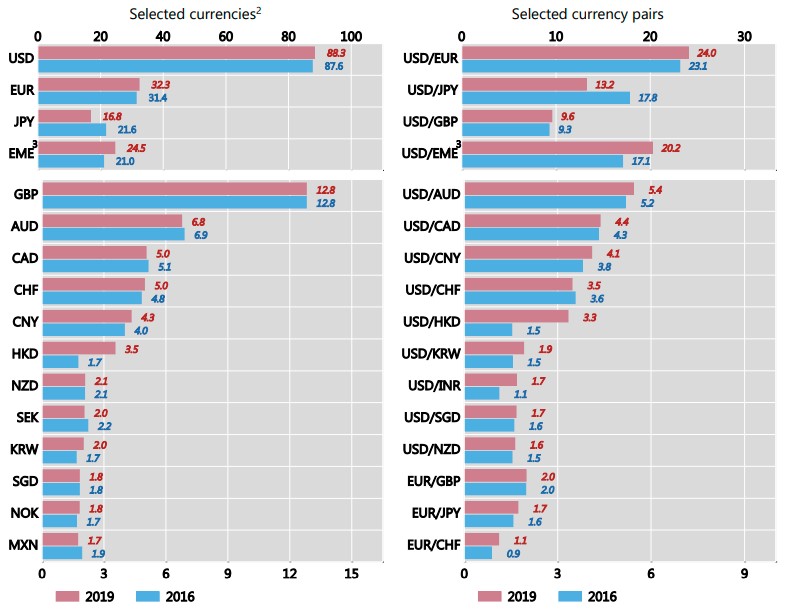
*Източник Bis.org
Като заключение мога да кажа, че за начинаещите е препоръчително да търгуват с по-малко на брой и по-ликвидни валутни двойки.
Сега когато знаеш, с какво да започнеш търговията, трябва да разбереш кога е препоръчително да се търгува. Не всяко време е добро за търговия, има дни и часове, които са опасни и трябва да се избягват.
Кои са те, ще научиш в следващата част от статията.
Кога да търгуваш
Както вече споменах, Форекс пазара е отворен 24 часа в денонощието, 5 дни в седмицата.
Не винаги обаче е активен, т.е. не винаги има движения, които да се търгуват. Можеш да търгуваш и да печелиш (или да губиш), когато цената върви нагоре. Дори можеш да търгуваш, когато цената е в низходяща посока.
Но има време, в което ликвидността е много ниска и пазара не се движи. Освен, че няма движение по това време, спреда става по-широк от обикновено.
Преди да разгледаме часовете за търговия, нека започнем от основните търговски сесии.
Форекс пазара може да бъде разделен на няколко търговски сесии:
- Сидни/Австралийска сесия;
- Токио/Азиатска сесия;
- Лондон/Европейска сесия;
- Ню Йорк/Американска сесия.
През деня има два пикови периода, в които се припокриват най-ликвидните сесии.
- Азиатско - Европейска (09:00 до 11:00 ч.);
- Американо - Европейска (от 15:00 до 18:00 ч.).
Най-подходящите часове за Форекс търговия, са когато ликвидността е голяма. По това време обемите са високи, а това се изразява в по-големи движения.
Нямам предвид да се търгува по време на новини, а по време на активните пазарни сесии. Начинаещите трейдъри трябва да избягват да търгуват по време на слабо ликвидните часове. Това е времето от 01:00 ч. до 09:00 ч., а сесиите са Австралийска и Азиатска .
Дните, които трябва да избягваш, като начинаещ трейдър са:
- Всеки първи петък на месеца - тогава излиза доклада за работните места в САЩ. По време на тази новина значително се повишава волатилността;
- Икономически събития - заседание на ФЕД, избори, публикуване на различни доклади;
- Почивни дни - всички празници, които предизвикват понижаване на активността в големите търговски центрове. Например 4-ти юли.
Повече за времето за търговия ще научиш в статията:
Важни форекс термини
- Маржин - Когато търгуваш на Форекс, от теб се изисква да депозираш по сметката си малка сума, за да отвориш и поддържаш позиция/сделка. Тази сума се нарича маржин;
- Ливъридж - Термин, известен още като “Кредитно рамо”, дава възможност да управляваш голяма сума пари, като използваш малка част от собствения си капитал, а останалата получиш от трета страна;
- Лот - Броя валутни единици, с които се търгува. Един лот може да бъде равен на 100 000 базови единици;
- Спред - Разликата между курс купува и курс продава;
- Пипс - Мерна единица, изразяваща промяната в обменния курс на две валути.
Повече за пипса и как да го изчисляваш, ще научиш в тази статия:
>> Какво е пипс във Форекс търговията
- Суап - В контекста на Форекс търговията, това е такса за пренос на позиция за следващия ден. Суапа може да бъде положителен или отрицателен, тоест брокера може да начисли или отчисли сума от търговската сметка;
- Технически анализ - Метод за прогнозиране движението на финансовите активи, чрез изучаване на предходните ценови движения;
- Къса позиция - Във Форекс търговията, този термин се свързва със сделка на продажба;
- Дълга позиция - Във Форекс търговията, този термин се свързва със сделка на покупка;
- BID цена - Цената, на която продаваш финансов инструмент;
- ASK цена - Цената, на която купуваш финансов инструмент.
Какво е маржин
Ако искаш да сключваш сделки в размер на $100 000, не е нужно да имаш $100 000 по сметката си, достатъчно е да депозираш $1000 например.
Точната сума зависи от условията на брокера, при който търгуваш и ливъриджа, който използваш.
Повече за ливъриджа, ще научиш от статията:
>> Какво е ливъридж на финансовите пазари
Маржин не е такса по сделка или комисионната на брокера. На финансовите пазари, маржин търговията се свързва с процеса, при който инвеститорите търгуват с повече, отколкото могат да си позволят.
Ако купуваш финансови активи на маржин, и тези активи повишат стойността си във времето, можеш да спечелиш много по-добра възвращаемост, отколкото ако търгуваш само със собствени средства.
Това е предимството на маржин търговията.
За да използваш маржин сметка, брокера иска да депозираш определена сума пари, за да поддържа отворените позиции.
Може да се каже, че маржи е част от капитала, който брокера отделя от баланса на сметката ти, за да поддържа отворените позиции и да си гарантира, че можеш да покриеш евентуални загуби от търговията.
Как точно става това?!
Научи всичко за маржин търговията от подробното ни ръководство:
Какво е маржин търговия във финансовата сфера
Научи как да изчисляваш необходимия маржин и всички необходими термини, за да разбираш маржин търговията.
Избор на брокер
Една от най-важните теми във Форекс търговията, е избора на доверен инвестиционен посредник (ИП)!
Внимавай къде си откриваш сметка за търговия и депозираш парите си!
Виж критериите, на които трябва да отговаря един брокер, за да му се довериш.
- Регулации - Преди да избереш брокер, в който да търгуваш, разбери дали е регулиран. ESMA задължава всеки брокер да опише на уебсайта си регулаторният орган и лицензионният си номер;
- Изпълнение - Изпълнението на сделките. Брокера трябва да използва високотехнологични мрежи и сървъри, за да осигури мигновено свързване с доставчиците на ликвидност;
- Такси - Спредове, такси и комисиони. Добре е брокера да предлага различни видове сметки, за да можем да изберем най-изгодната за търговия;
- Поддръжка - Поддръжка и съдействие от страна на служителите на брокера на Български език;
- Прозрачност - Достъп до правна информация, документи, условия, всичко да е достъпно за потребителя.
През последните 6 години търгуваме в един от най-добрите брокери в света!
За това време успяхме да изградим силно партньорство с брокера и вече сме над 400 трейдъра в една общност с огромни предимства.
Отвори сметка за търговия в нашите партньори и ще получиш:
- Cashback до $1 на лот;
- Един месец достъп до затворена група за трейдинг анализи;
- До 70% индивидуални отстъпки от услугите ни;
- Достъп до роботизирани системи;
- Leverage до 1:500.
Cashback до $1 лот и общност TRENDLINE!
От TRENDLINE внимателно подбрахме едни от най-добрите Форекс брокери в света. Виж 7 причини, поради които трябва да търгуваш с тях.
Демо сметка
Ако искаш да се научиш да търгуваш успешно, задължително трябва да откриеш демо сметка.
Ето защо:
С демо сметката започваш да търгуваш веднага, без да рискуваш собствен капитал. Демото наподобява реалният акаунт, за да осигури възможно най-близки условия до реалната Форекс търговия.
Тестваш различни методи и стратегии за търговия напълно безрисково. Изграждаш правилни и полезни навици, за да не допускаш грешки на реалната сметка.
В този ред на мисли, когато откриваш демо, виртуалната сума, с която търгуваш не трябва да е по-голяма от реална сумата, която ще депозираш по реалната сметка. Демо сметката се използва, за да свикнеш с платформата за търговия.
Няма стандартен период, който да прекараш на демо, тъй като при всеки този период е различен. Освен това, след като започнеш да търгуваш на реална сметка, все още можеш да използваш демото, за да тестваш стратегии за търговия.
След като се запознаеш с функциите и бутоните на платформата, открий малка реална сметка, за да свикнеш с психологическата страна на търговията.
В следващите редове ще научиш отговорите на най-често задаваните въпроси за платформата за търговия!
Платформа за Форекс търговия MetaTrader 4/5
Търговията на финансовите пазари се извършва чрез търговски терминал, познат още като платформа за електронна търговия.
Платформата за електронна търговия представлява софтуер, който се използва за изпълнение на поръчки (сделки) на финансови продукти, чрез финансов посредник (брокер).
Платформите за търговия MetaTrader 4 или MetaTrader 5 са платформи за електронна търговия, разработени от MetaQuotes и предназначени за използване от финансови институции извършващи брокерска дейност.
MetaTrader 5 е по-новата версия на платформата, но това че използваш по-нов софтуер, не значи че ще си по-ефективен трейдър. Спокойно можеш да използваш и по-старата версия, ако си свикнал с нея.
Ние като трейдъри, можем да използваме MetaTrader, чрез инвестиционен посредник/брокер.
Ето и най-често задаваните въпроси, свързани с платформата за търговия:
Откъде да изтегля MetaTrader 4/5
Можеш да изтеглиш MetaTrader от сайта на всеки брокер, който предлага платформата на своите клиенти. За персонален компютър, MetaTrader се предлага във версия за Windows, Mac OS и Linux.
За смартфони и таблети, версиите са за iPhone/iPad, Android и Huawei.
Имай предвид, че заради големината на мобилното устройство, то не е подходящо за анализиране на пазара - особено от начинаещи.
През мобилно устройство, можеш да затвориш сделка, преместиш Take Profit и Stop Loss или дори да сключиш сделка, но вече след като си анализирал графиката на голям дисплей и знаеш какво се случва на пазара.
Как да вляза в сметката за търговия
След като инсталираш платформата за търговия, тя ще се стартира автоматично.
На екрана ще се появи прозорче, в което трябва да въведеш потребителско име, парола и сървър.
При регистрация на сметката, независимо демо или реална, брокера автоматично ще изпрати необходимите данни (име, парола и сървър) на имейл адреса от регистрацията. Ако не го намираш в основната папка, провери спам или другите папки в имейла.
Често допускана грешка при въвеждането на данните, е да се копира номера на сметката и паролата директно от имейла, но заедно с интервал. По този начин платформата не може да разпознае номера или паролата и няма да се свърже със сметката.
Друга грешка е да се въведе неправилен сървър. Ако имаш затруднения, винаги можеш да се свържеш с нас, за да съдействаме.
Как да сключа сделка
Сделка се сключва от бутона “Нова поръчка”, който се намира в горната част на терминала.
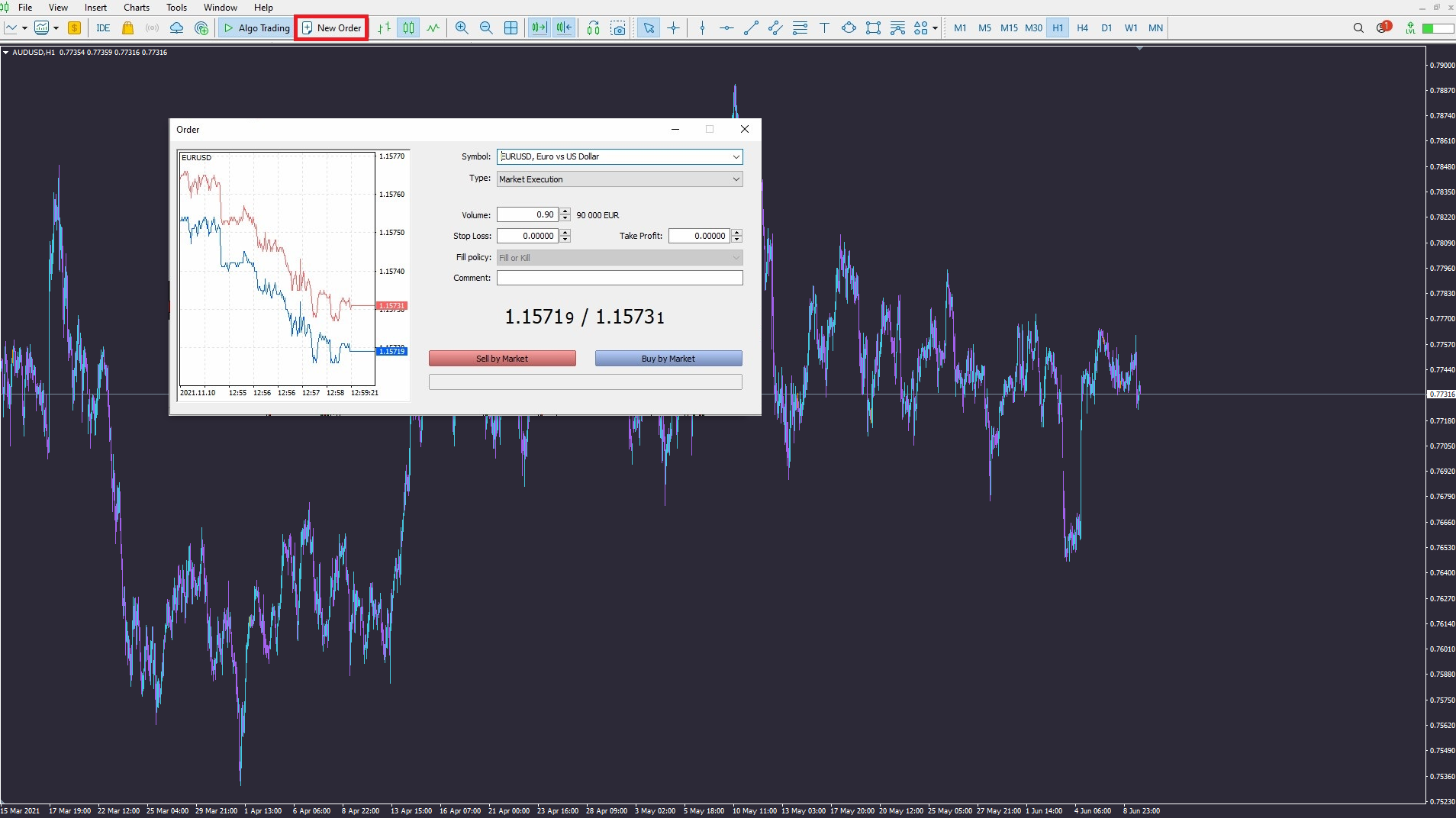
След натискане на бутона, ще се появи прозорец, в който трябва да въведеш обем/Lot на позицията, Stop Loss и Take Profit.
Обема на сделката, не трябва да е произволно избран, а трябва да е съобразен с размера на стопа.
Тук засягаме най-важната част от Форекс търговията - УПРАВЛЕНИЕТО НА КАПИТАЛА!
Повече за управлението на капитала, надолу в статията.
Можеш да сключиш сделката и без Stop Loss и Take Profit, но не е желателно.
Също така има поле, в което да въведеш коментар към сделката, например защо е сключена. След въвеждане на параметрите по сделката, натискаш един от бутоните “Продажба на пазар” за сделка на продажба, или “Покупка на пазар” за сделка на покупка.
Това е, вече имаш сключена позиция на MetaTrader 4.
Освен да сключваш сделки с пазарно изпълнение, можеш да поставяш и чакащи поръчки, които да се активират при изпълнение на определено условие.
Не е необходимо да стоиш пред платформата за търговия през цялото време.
Можеш да настроиш отложена поръчка да се активира и да сключиш сделка автоматично, когато цената достигне определено ниво например. Можеш също така, да поставиш Stop Loss, който се движи заедно с цената (Trailing stop).
Научи всичко за отложените поръчки от статията “Видове Форекс поръчки и как да ги използваш”.
Видове Форекс поръчки и как да ги използваш
Разбери как да използваш Форекс поръчките по време на търговия.
Как да намеря инструментите за търговия
Това, е може би най-често задавания въпрос от начинаещите трейдъри.
Когато инсталираш платформата за търговия, не всики инструменти се виждат. При всеки брокер е различно, но най-често се виждат основните валутни двойки, някои кросове и злато.
Така начинаещите решават, че това са всички инструменти и търсят друг брокер.
Ето къде се крият останалите търгувани инструменти!
В горната част на терминала има бутон “Състояние на пазара”, трябва да кликнеш на него, за да се появи полето с инструментите за търговия.
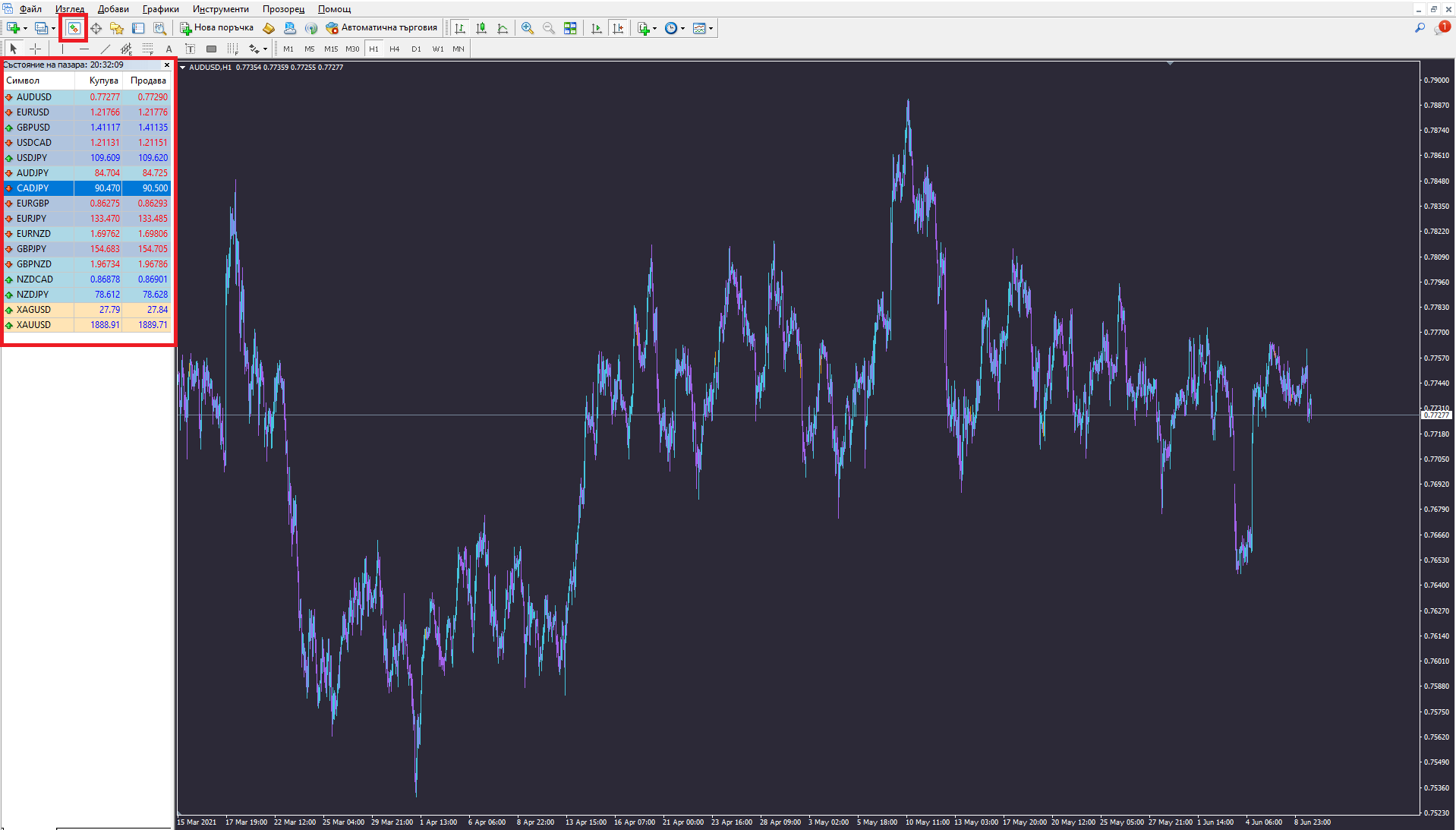
Както е показано на изображението, все още не се виждат всички инструменти.
За да ги добавиш, трябва да кликнеш с десен бутон на мишката на произволно място от полето с инструменти.
Ще се появи прозорец, на който трябва да кликнеш на бутона “Покажи всички”.
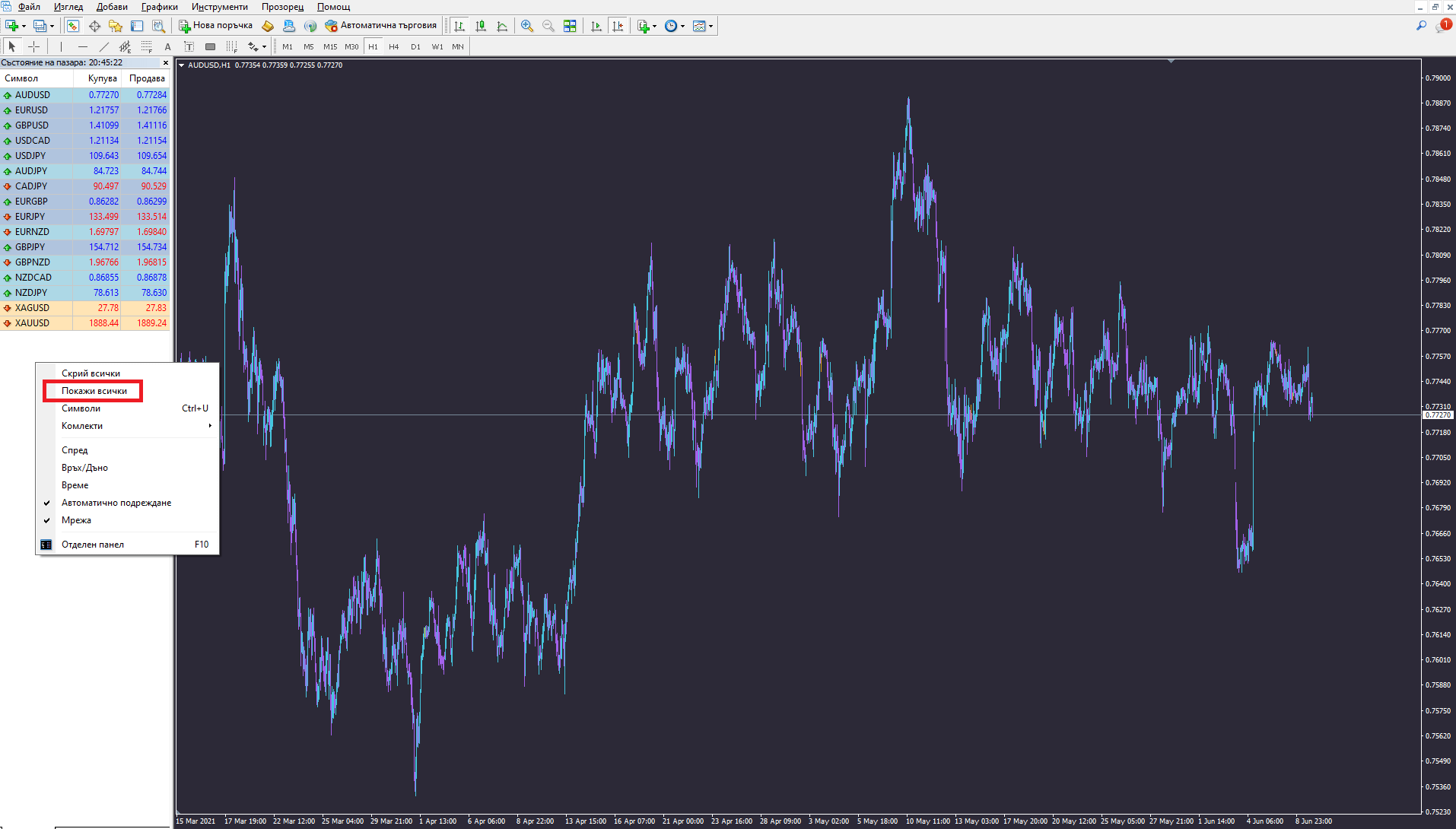
Вече всички инструменти се виждат.
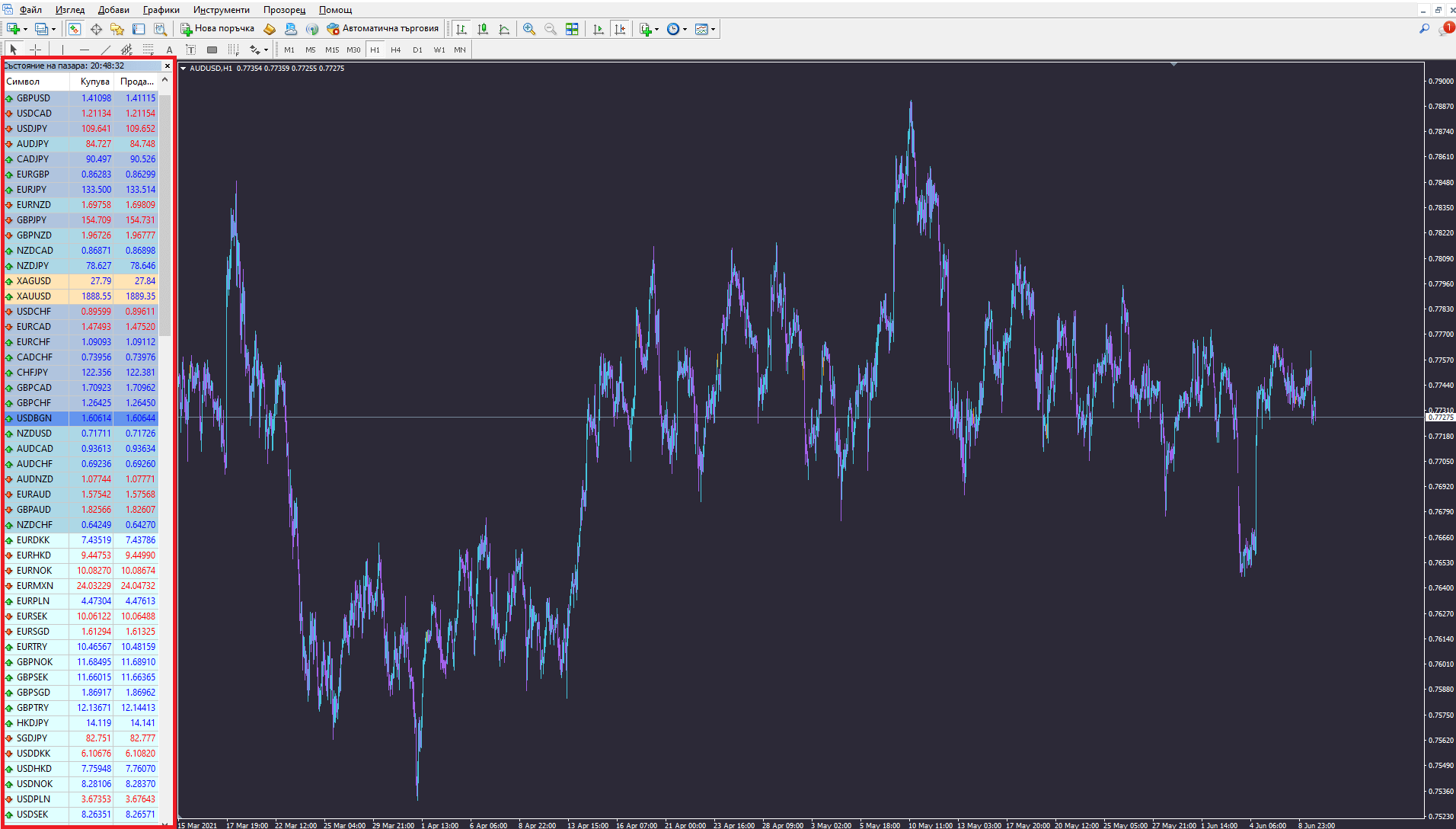
След като имаш платформа и сметка за търговия, следващата стъпка е да започнеш да учиш технически анализ.
“Как да правя технически анализ?”
Е, в следващата глава ще разбереш точно това!
Технически анализ
Техническият анализ е метод за анализиране на финансовите пазари.
Целта му е да прогнозира вероятни движения на основата на аналогични изменения в цените на инструментите в минал период, при сходни обстоятелства.
Техническите анализатори смятат, че бъдещото движение на цената може да се прогнозира на база изминал период.
Технически анализ може да се прилага на всички пазари, където са налице исторически данни за движението на цената.
За основател се смята Чарлз Дау.

Той приема три основни принципа на техническият анализ:
- Цената отчита всичко;
- Цените се движат насочено;
- Историята се повтаря.
Цената отчита всичко
Първият принцип се базира на предположенията, че текущата цена вече е отразила всички очаквания, слухове, новини и други фактори оказващи влияние.
За доказване на този принцип, най-често се използват японските свещи. Този метод се нарича свещен анализ и се прави с помощта само на японските свещи.
Целта е да се прогнозира бъдещото ценово движение на база единични свещни модели или формации от няколко свещи.
Някои от най-известните формации от свещи са:
- Doji;
- Hanging man;
- Shooting star;
- Hammer;
- Reversed hammer;
- Spinning Top;
- Bearish engulfing;
- Bullish engulfing.
Както при всеки един анализ, препоръката ни е, да търсиш причината поради която се случва определено движение, логиката, която стои зад движението. Ако се затрудняваш с откриването им, имаме решение за теб!
В Trendline сме разработили експертна система, която открива над 30 различни формации и модели от свещи. Приложима е на всички пазари и времеви периоди, и лесно може да се интегрира към всяка стратегия.
Candlestick Patterns EA
Candlestick Patterns EA е еднакво приложим на всички пазари. Независимо дали търгуваш валути, злато, криптовалути или акции, робота ще открива формации и потенциални сделки вместо теб.
Цените се движат насочено
Тук се имат предвид трендовите движения.
Когато цената се движи в определена посока, вероятността да продължи движението си в същата посока, е по-голяма отколкото да смени посоката си.
Разбира се, тук говорим за вероятности и винаги идва момента, в който тренда сменя посоката си.
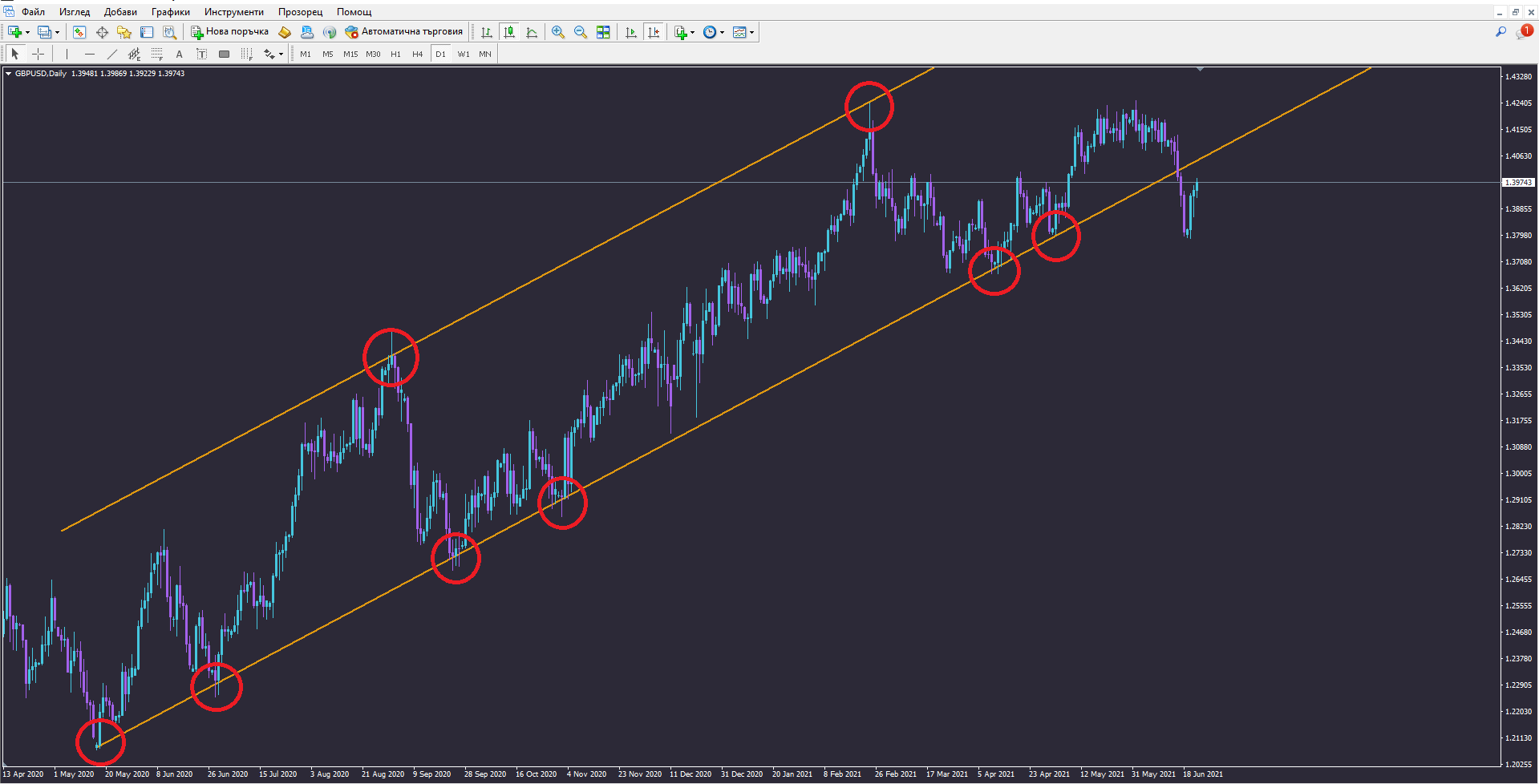
На графиката можеш да видиш възходящ тренд на валутната двойка GBPUSD. Цената се движи насочено в трендовия канал и няколко пъти дава сигнали за сделка.
Както виждаш, в определен момент тренд линията е пробита и това е първия сигнал за смяна на тренда (но не е достатъчен, за да смятаме тренда за обърнат).
Историята се повтаря
Тук говорим за всички модели на техническия анализ.
Този принцип се базира на предположенията, че щом определен модел се е случил няколко пъти в миналото, очакваме, че и занапред ще продължи да се случва по същият начин.
В заключение ще добавя, че има два основни вида технически анализ. Анализ на графични модели (Chart patterns) и анализ чрез технически индикатори. Повече за методите на технически анализ, ще научиш в следващите статии.
Сега преминаваме към следващият метод на анализ, а именно Фундаментален анализ.
Фундаментален анализ
Фундаменталният анализ, е метод за анализиране на ценовите движения, чрез изследване на икономически, политически и финансови фактори.
В контекста на Форекс търговията, фундаменталния анализ изучава макроикономическите и политически фактори, които могат да окажат влияние на икономиката на дадена страна. Респективно да окажат влияние на валутата на тази страна.
Целта на анализа, е да определи дали дадена валута е подценена или надценена спрямо текущата пазарна цена.
Важни данни и събития, които могат да окажат влияние на цената са:
- Общо състояние на икономиката;
- Импорт/Експорт;
- Лихвен процент;
- Брутен Вътрешен Продукт (БВП);
- Ниво на безработицата;
- Политически събития;
- Референдуми и др.
Различните показатели могат да окажат различно влияние на цената, като стойност и продължителност. Що се отнася до икономическите показатели (например БВП), не е важно каква е текущата стойност, а как тя се е променила спрямо предходния период.
Ако има покачване на БВП спрямо предходния период, това се счита за положителен фактор и би трябвало да окаже положително влияние върху валутата на съответната страна.
Освен икономически, политически и финансови фактори, има още едни събития, които могат да въздействат на цената на валутата.
Това са природните събития.
Земетресения, наводнения, изригвания на вулкани, всичко, което причинява щети и изисква разходи за покриването им. Това съответно оказва влияние върху икономиката на страната, а от там и на валутата.
След като разгледахме основните методи на анализ - технически и фундаментален, разбери как да ги приложиш на практика!
Ако искаш да разбереш как да търгуваш и да откриваш сделки, следващата част определено е за теб!
Форекс стратегия
Стратегията за Форекс търговия е техника за определяне на момент за вход в сделка.
Целта на стратегията е да даде сигнал за покупка или продажба, като отговори на определени условия.Стратегията може да се базира на технически или фундаментален анализ.Стратегиите за търговия на Форекс могат да бъдат ръчни или автоматизирани методи за генериране на сигнали за търговия.
Ръчните стратегии изискват трейдъра да стои пред компютъра и да следи за сигнал за вход в сделка.Автоматичните системи представляват алгоритъм, който анализира пазара и генерира сигнали автоматично - без човешка намеса.
Добре е да започнеш с проста стратегия, за да свикнеш да следиш за изпълнението на условията, на които трябва да отговаря.Най-елементарната Форекс стратегия включва трендовият индикатор Moving Average (Пълзяща средна).
Как генерира сигнали за сделки стратегията с Moving Average?
Точно това ще опиша сега.
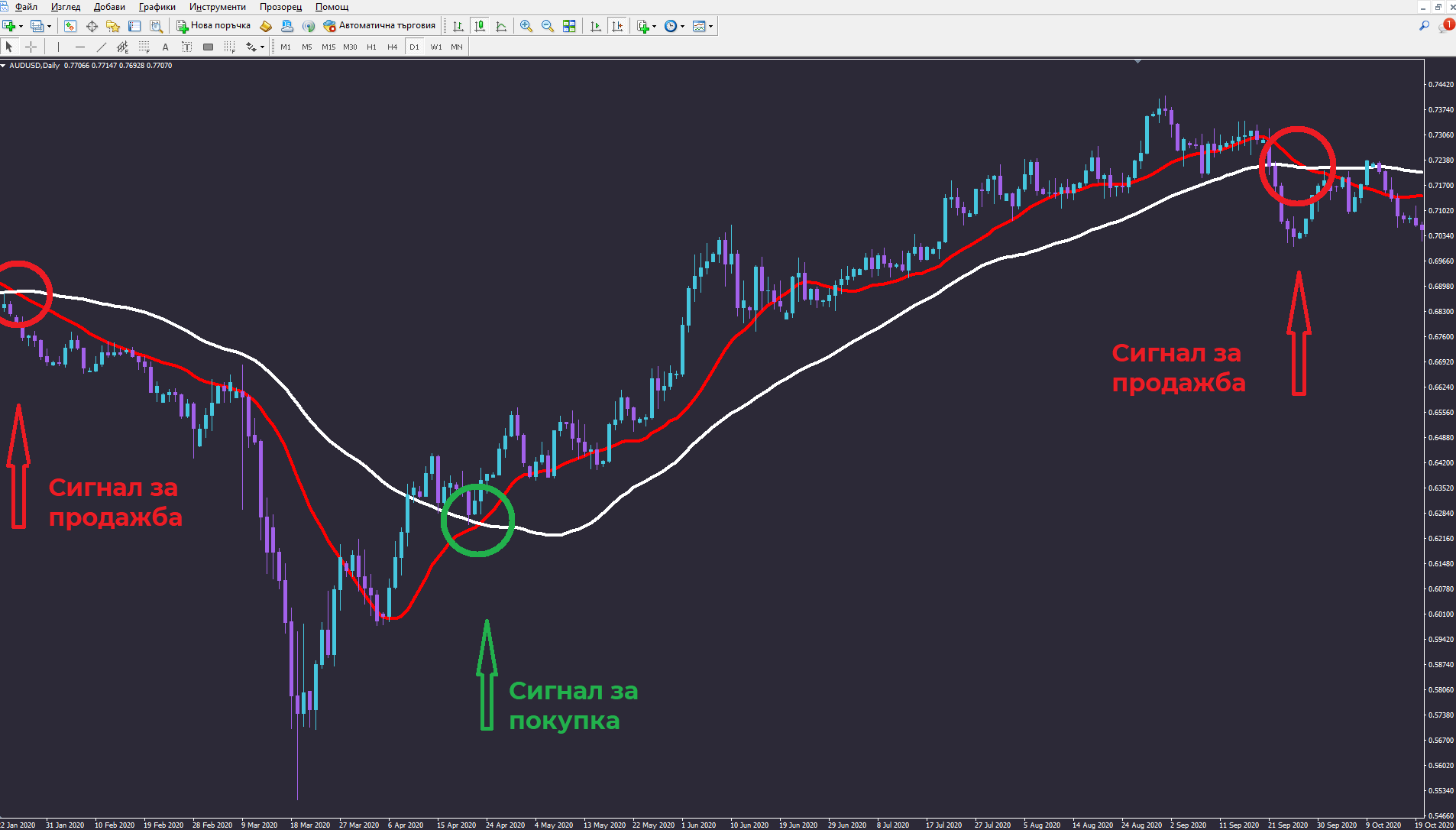
За да получиш сигнал за сделка, трябва да видиш пресичане на две пълзящи средни.
На изображението горе виждаш пресичане на 20 периодна и 50 периодна пълзяща средна. Червената линия е 20 периодна (МА 20), а бялата - 50 периодна пълзяща средна (МА 50).
Сигнал за сделка има, когато:
- МА 20 пресече МА 50 от долу нагоре - сигнал за покупка;
- МА 20 пресече МА 50 от горе надолу - сигнал за продажба.
Както споменах в началото, това е елементарна стратегия и целта и е да помогне за изграждането на правилни навици. Не се опитвай да търгуваш на реална сметка с тази стратегия!
Свикни да наблюдаваш пазара, да следваш правила и най-вече да използваш управление на капитала към стратегията си.
И като стана въпрос, в следваща глава ще научиш основите на управлението на капитала.
Управление на капитала
От съществено значение е да можеш да си определиш правилно риска по сметката и конкретно по всяка позиция. Без да знаеш с какъв обем да сключваш сделки е невъзможно да постигнеш устойчив резултат при търговията.
Ако подхода ти е грешен, това може да доведе потенциално печеливша сделка, до губеща такава. Дори нещо повече, грешките при определяне на обема за търговия могат да провалят цяла стратегия.
Обратното също е в сила - правилният риск мениджмънт, може да промени резултатите и на не чак толкова добра стратегия.
Запомни, че винаги се започва от размера на стопа!
Често срещана грешка, особено при начинаещите е, че оставят определянето на стопа за накрая.Преди да влезеш в сделка, помисли къде ще пласираш поръчката за ограничаване на загубите.След това измери разстоянието между нивото на вход и нивото на Stop Loss поръчката.
Никога не мести стопа по-близо до входа, за да купиш или продадеш повече лотове.
За всеки случай ще кажа, че размера на стопа се измерва в пипсове.
Повече за управлението на капитала ще научиш в статията:
Обобщение
Технически погледнато, сключването на сделки става с един клик на бутона на мишката.
Търговията на Форекс пазара обаче, е дейност, като всяка друга.
Отдели време, за да научиш основите на търговията и това ще ти спести много време и пари.
Ако трябва да акцентирам на най-важното от статията, а и като цяло от търговията, това е избора на брокер и управлението на капитала.
Бъди много предпазлив при избора на брокер, свържи се с нас, ако имаш затруднения или смяташ, че нещо не е наред с твоя инвестиционен посредник.
И накрая, но не и по важност, винаги смятай риска по сделките и поставяй Stop Loss!
Успешна търговия!
Предупреждение за риск: Всички продукти и услуги, предлагани от „Форекс Трендлайн“ ООД, са с изцяло образователна цел и не представляват инвестиционен съвет или препоръка за търговия. Търговията с финансови инструменти носи висок риск и може да доведе до загуби. Постигнати резултати в миналото не са гаранция за бъдещи успехи. Препоръчваме да се запознаете с пълните Общи условия преди използване на услугите ни. Нищо на този сайт не трябва да се тълкува като инвестиционен съвет от страна на „Форекс Трендлайн“ ООД или който и да е от неговите представители, директори или служители.
© 2026 Trendline. Всички права запазени
